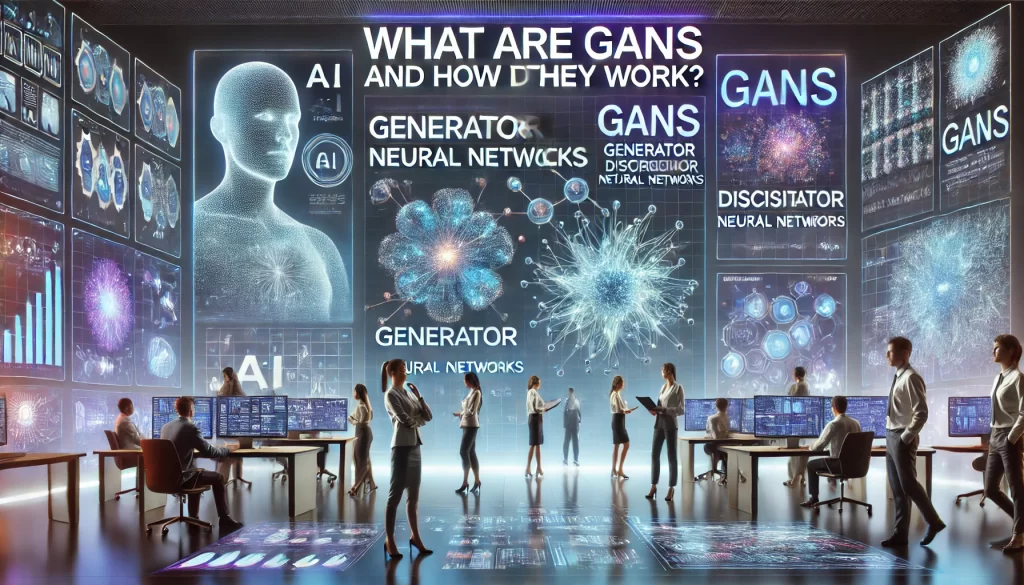
Generative Adversarial Networks (GANs) are a type of machine learning model made up of two competing neural networks: a generator and a discriminator. The generator creates fake data that resembles real data (such as images, text, or audio), while the discriminator tries to distinguish between the real data and the generated data. These two networks are set against each other in a “game” where the generator attempts to create increasingly realistic data to “fool” the discriminator, and the discriminator improves its ability to detect real vs. generated data. This adversarial process drives both networks to improve; the generator learns to produce data that is closer to real-world examples, and the discriminator gets better at identifying subtle differences. Over time, this results in the generator producing highly realistic samples, making GANs powerful tools for image generation, data augmentation, and various creative applications like art generation and style transfer.
What are GANs?
At its core, a GAN is a class of machine learning framework that allows two neural networks to “compete” with each other in a process known as adversarial training. The two networks, called the Generator and the Discriminator, work in tandem to produce data that’s similar to a given dataset. The Generator tries to create fake data that is as realistic as possible, while the Discriminator attempts to identify the difference between real and fake data.
Key Components of GANs
A GAN consists of two primary components:
- Generator: The Generator network is responsible for producing data samples. For example, if we’re using a GAN to generate images of cats, the Generator will create fake cat images.
- Discriminator: The Discriminator network evaluates the generated data and distinguishes between real and fake samples. It’s a binary classifier trained to give feedback to the Generator about how realistic the generated samples are.
How Do GANs Work?
The functioning of a GAN can be thought of as a game between the Generator and Discriminator, where each component strives to outperform the other. Here’s a step-by-step breakdown of the process:
- Data Input: The Generator begins with a random noise vector as input. This vector will be transformed into a data sample that the Generator will attempt to make look realistic.
- Data Generation: Using the noise vector, the Generator creates a “fake” data sample that resembles the target data set (e.g., images of cats, handwritten digits, etc.).
- Evaluation by Discriminator: The generated data is then passed to the Discriminator, which also receives real samples from the actual data set. The Discriminator’s job is to assign a label to each sample, predicting whether it’s real or fake.
- Feedback Loop: Based on the Discriminator’s output, both networks adjust their parameters to improve. If the Discriminator correctly identifies fake data, it strengthens its ability to detect generated samples. Conversely, if the Generator successfully fools the Discriminator, it refines its technique to create even more realistic samples.
- Repetition: This process continues iteratively, with the Generator learning to produce increasingly realistic samples over time, while the Discriminator gets better at distinguishing real from fake data.
- Convergence: Ideally, the GAN reaches a point where the Discriminator can no longer reliably tell the difference between real and generated samples, achieving what’s known as equilibrium.
Why Are GANs So Powerful?
GANs are unique because they allow unsupervised learning—creating new data without the need for explicit labels. This capability has opened up a multitude of applications:
- Image Generation and Enhancement: GANs are widely used in creating high-resolution images, transforming low-quality images into HD, and even converting sketches into lifelike photos.
- Art and Creative Applications: GANs can create digital art, compose new music, and even design objects.
- Medical Imaging: In healthcare, GANs are helping improve medical imaging by enhancing resolution and generating synthetic scans for training purposes.
- Gaming and Virtual Reality: GANs have made it possible to generate realistic textures, characters, and environments for immersive gaming and virtual experiences.
Challenges in GAN Training
Although GANs are incredibly powerful, training them can be quite challenging due to:
- Instability: The adversarial process can lead to situations where the Generator or Discriminator becomes too strong, making training unstable.
- Mode Collapse: Sometimes, the Generator learns to produce only a few types of samples, leading to a lack of diversity in generated data.
- Computational Demand: GANs require significant computational resources and time for training, especially for high-quality results.
Types of GANs
Since their inception, several variations of GANs have been developed to improve performance and expand applications:
- Conditional GANs (cGANs): These use additional information (e.g., labels) to guide the data generation process.
- CycleGANs: Primarily used for style transfer, such as transforming images from one domain (e.g., photos) to another (e.g., paintings).
- StyleGANs: These are popular for generating high-resolution, photorealistic images and are widely used in creative industries.
Final Thoughts
Generative Adversarial Networks have revolutionized how we generate and work with synthetic data, finding applications across entertainment, art, healthcare, and beyond. Though they come with challenges, the potential of GANs continues to push the boundaries of what’s possible in AI.
Whether you’re a developer, researcher, or AI enthusiast, understanding GANs provides insight into one of the most transformative technologies of our time. The future holds even more innovation as we continue to refine GANs and discover new applications in artificial intelligence.
